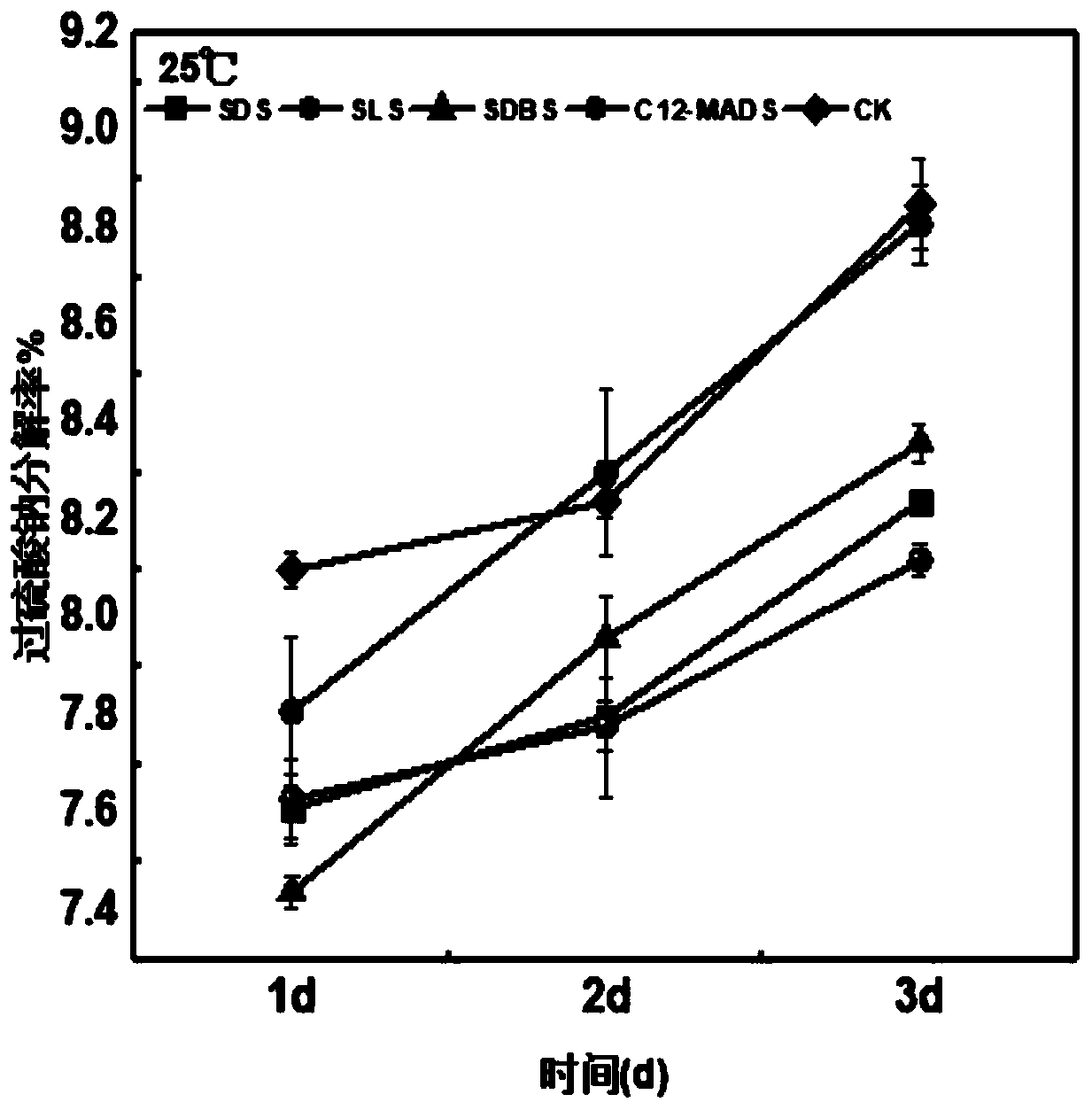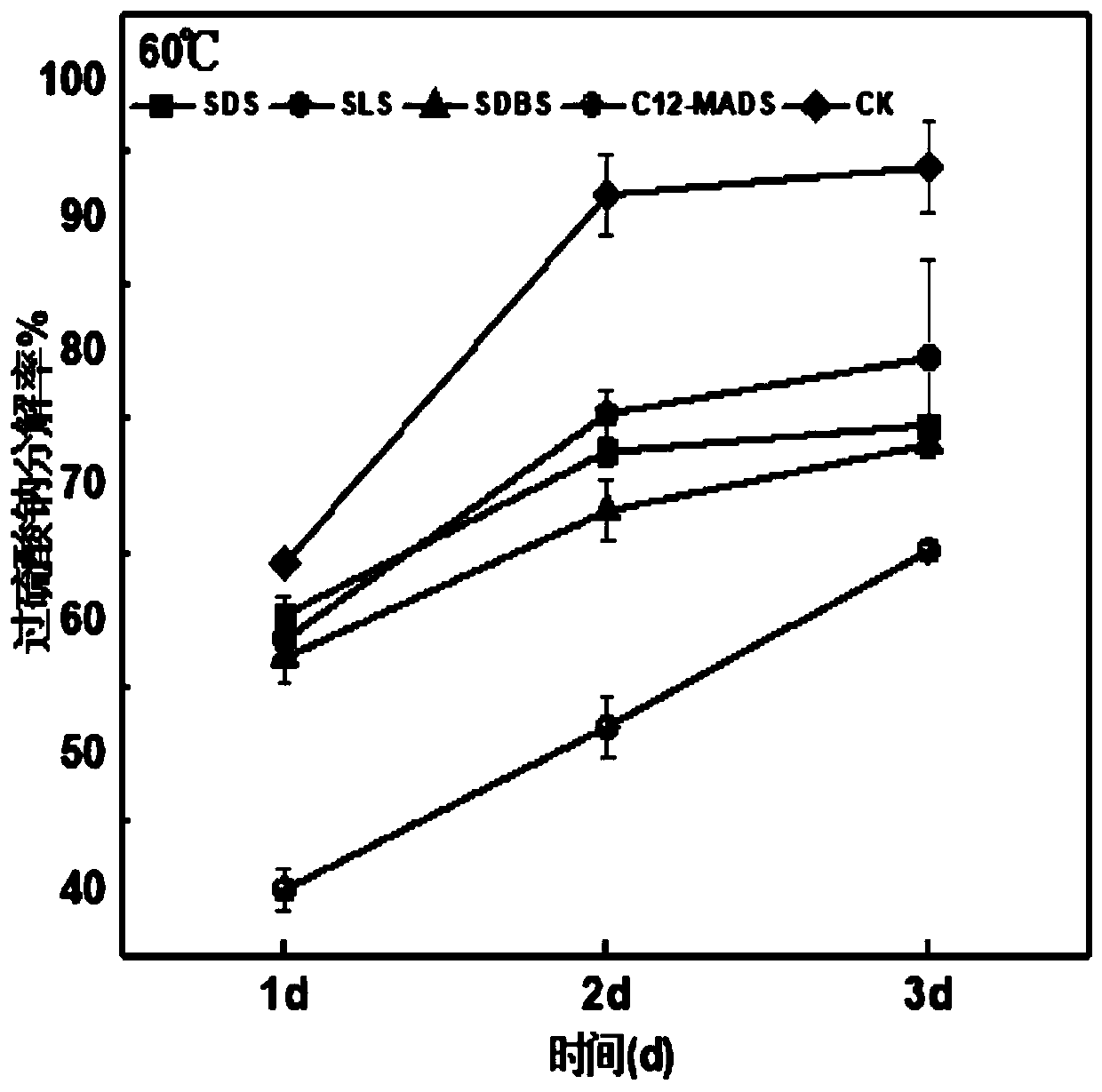Method for repairing organic matter contaminated soil with reinforced persulfate
A technology for polluted soil and persulfate, applied in the field of polluted soil remediation, can solve the problems of poor stability of sulfate radicals, low removal rate of organic pollutants, low effective utilization rate of persulfate, etc., and achieve stable solubilization effect. , Improve the effect of continuous action, avoid the effect of rapid decomposition
- Summary
- Abstract
- Description
- Claims
- Application Information
AI Technical Summary
Problems solved by technology
Method used
Image
Examples
Embodiment 1
[0035] Take by weighing 50g sodium persulfate and take by weighing 5g surfactant (sodium dodecylsulfonate (SDS), sodium dodecylbenzenesulfonate (SDBS), sodium dodecylsulfate (SLS), lauryl sulfate respectively Sodium alkyl diphenyl ether disulfonate (C 12-MADS)) was dissolved in 1L of deionized water, placed in a stirrer and stirred evenly, 20mL was added to a sample bottle, placed in a constant temperature shaker, and the temperature was maintained at 25, 40, 60, and 80°C respectively. One set of samples was taken separately and frozen in an ice-water bath to stop the reaction. Use a pH meter to measure the pH value of the sample, and use an automatic potentiometric titrator to quantify the remaining sodium persulfate content.
[0036] The result is as Figure 1 ~ Figure 4 Shown, along with the raising of sodium persulfate heating temperature and the prolongation of heating time, sodium dodecyl diphenyl ether disulfonate (C 12 -MADS) group had the slowest decomposition rate...
Embodiment 2
[0038] Weigh 25g of sodium persulfate and dissolve it in 1L of deionized water, put it in a stirrer and stir evenly, take 20mL and add it to 1g of soil, put it in a constant temperature oscillator and react for 1, 4, 8, 12, 16h, then take it out, keep 150rpm, 60 ℃; the sample taken out was centrifuged by a high-speed centrifuge and kept at 4000rpm for 10 minutes; after solid-liquid separation, the soil part was added to the extraction solution of acetone: n-hexane = 1:1 for ultrasonic extraction, and vortexed for 2 minutes before ultrasonic extraction 10min, and finally centrifuged by a high-speed centrifuge at 4000rpm for 10min, the supernatant was taken, and repeated three times. The removal efficiency of phenanthrene in this example is 59.78% (1h), 64.82% (4h), 67.32% (8h), 69.44% (12h), 72.01% (16h).
Embodiment 3
[0040] Weigh 25g of sodium persulfate and 1g of sodium dodecyl diphenyl ether disulfonate, dissolve them in 1L of deionized water, put them in a stirrer and stir evenly, take 20mL and add them to 1g of soil, and put them in a constant temperature oscillator to react 1, 4 , Take it out after 8, 12, and 16 hours, keep it at 150rpm, 60°C; centrifuge the taken out sample through a high-speed centrifuge, keep it at 4000rpm, for 10 minutes; add acetone to the soil part after solid-liquid separation: n-hexane = 1:1 extract Ultrasonic extraction was performed, vortexed for 2 minutes, then ultrasonically extracted for 10 minutes, and finally centrifuged by a high-speed centrifuge at 4000 rpm for 10 minutes. The supernatant was taken and repeated three times. The removal efficiency of phenanthrene in this example is 68.14% (1h), 71.99% (4h), 76.22% (8h), 82.73% (12h), 84.40% (16h).
PUM
 Login to View More
Login to View More Abstract
Description
Claims
Application Information
 Login to View More
Login to View More - R&D
- Intellectual Property
- Life Sciences
- Materials
- Tech Scout
- Unparalleled Data Quality
- Higher Quality Content
- 60% Fewer Hallucinations
Browse by: Latest US Patents, China's latest patents, Technical Efficacy Thesaurus, Application Domain, Technology Topic, Popular Technical Reports.
© 2025 PatSnap. All rights reserved.Legal|Privacy policy|Modern Slavery Act Transparency Statement|Sitemap|About US| Contact US: help@patsnap.com



